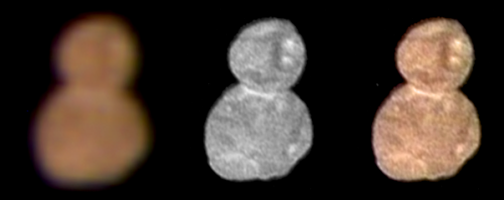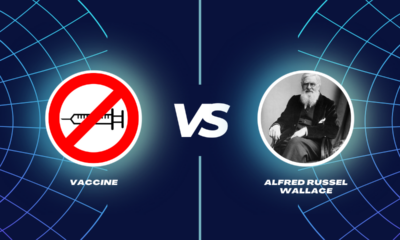Creation Corner
Trans-Neptunian objects: just how heavy?

The recent (understandable!) interest in the object Ultima Thule (2014-MU69) reminds us of a puzzle about the outer Solar system. Specifically: just how heavy are all the Trans-Neptunian Objects, if you combine them? That question has direct relevance to the most comprehensive creation theory, the Hydroplate Theory of Walter T. Brown. Someone, about a year ago, cited two articles that separately allege that all the Trans-Neptunian Objects is at least a tenth as heavy as the Earth itself. In fact, the authors assert that all the TNOs might be half as heavy as the Earth! So before the origins debate bogs itself down in any more confusion, let’s look—hard—at the sources.
What are Trans-Neptunian Objects?
Trans-Neptunian Objects include all objects that:
- Orbit the Sun at semi-major axes longer than the semi-major axis of the order of the planet Neptune, or
- Orbit other objects that so orbit the Sun.
Clyde Tombaugh at the Lowell Observatory famously discovered the first of these objects. He named it Pluto, after the God of Wealth and the dark underworld in classical mythology. He had been looking for a planet beyond Neptune. For decades astronomer accepted his find as “the ninth planet,” until the discovery of Eris, in the Scattered Disk (the “outer” part of the TNO region). The International Astronomical Union then created a new definition: dwarf planet, meaning one that still had junk in its orbit.
Today astronomers regard Pluto as the largest object in the Kuiper Belt, the “inner” TNO region. In July 2015, the rocket probe New Horizons famously visited Pluto. Sadly, most astronomers still have not come to grips with all the insights one can glean from that visit.
One example will suffice here. No astronomer says one word about the lake of frozen carbon monoxide in the western lobe of Tombaugh’s Heart. That much carbon monoxide can only have come from burning wood in a confined space eventually lacking in oxygen. That space was the core of Pluto, where the heat of accretion started a fire. Organic material—from Earth—fueled that fire.
Why are Trans-Neptunian Objects so important?
Conventional astronomers insist that all Trans-Neptunian Objects are the remnants of a “planetesimal” that failed to form with the rest of the Solar system. But in 2012 came the discovery of yet another object, like the far-off dwarf planet Sedna (2012-VP113). This object has a semimajor axis of 80 AU. Megan E. Schwamb observed at once that this cannot be a coincidence:
The two objects [Sedna and 2012 VP113] have similar values for one of their orbital parameters: the angle [ω] between the point of perihelion and where the orbit crosses the plane of the Solar System [from south to north]. Interestingly, the most distant [TNOs], with semimajor axes greater than 150 AU and perihelia beyond Neptune, also seem to have values for such angles comparable to those of Sedna and 2012 VP113. Such clustering of orbital angles seems to be unexplainable by the gravitational influence of Neptune alone. This result may be the first hint we have of an identifiable signature of the … formation mechanism [for TNOs]. If true, any formation mechanism proposed for the origin of Sedna and 2012 VP113 [and the other ten most distant TNOs] will need to explain this orbital structure.1
The particular orbital element Dr. Schwamb mentioned is the argument of periapsis. This becomes the argument of perihelion for any object orbiting the Sun. When twelve objects have the same value for this orbital element, they must have come from the same place.
An earthly origin
Walter T. Brown had, of course, developed a theory of the Global Flood. The Hydroplate Theory identifies the “Fountains of the Great Deep” as a subcrustal ocean. Initially he thought this ocean once lay ten miles underground. On the day of the Flood, the crust ruptured. The escaping waters eroded the rupture site away for 400 miles on each side. That much erosion, with a ten-mile-thick crust, would account for the masses of the comets, the asteroids, and the meteoroids.
But now Brown decided: he must account for the Trans-Neptunian Objects. What process would have formed them, separately and apart from the Flood, but having to do with Earth? Answer: none. The scientific method demands simplicity wherever possible. The simple explanation became: the Earth’s crust must have been even thicker. His calculation: a 50-mile thickness. Subsequently, a seismological team, working in New Zealand, took soundings, looking for the floor of a tectonic plate. They found instead an echo about 50 miles down. In short, they found the roof of the subcrustal chamber. And they never knew it.2
What total mass must one account for?
Dr. Brown consulted several sources for the masses of all known “mavericks” in the Solar system. These sources inform us that:
- The Earth itself weighs 5.9722 x 1024 kilograms. Anyone can determine that by repeating Henry Cavendish’s experiment to find the Gravitational Constant, G. Then M = gR2/G, where R is the radius of the Earth and g is acceleration due to gravity.
- All the “inner” asteroids, including the dwarf planets Ceres and Vesta, weigh 2.6 x 1024 grams. That’s 2.6 x 1021 kilograms. In other words, the asteroids, weighing together, weigh 0.043 percent of what the Earth weighs.
The mass of all the Trans-Neptunian Objects is significantly higher. Brown would expect that. To become a Trans-Neptunian object, any object would need to propel itself to a very far orbit. Such an object would have to be much larger than even the largest asteroid.
Lorenzo Iorio, in 2007, estimated that total mass at 4 percent of the mass of the Earth. He reasoned this from measuring its likely effect on the orbits of the true planets.3
Cesar Fuentes and Matthew J. Holman, in 2008, simply examined images of Trans-Neptunian Objects in astronomical archives. They totted up their likely masses and guessed that all the TNOs weigh 2 percent of what the Earth weighs.4
Which is correct?
Whichever estimate is correct, the total mass of the asteroids, at 0.04 percent of the Earth’s mass, pales in comparison. Furthermore, even the weight of any or all of the large moons of Saturn is even less significant. Any one of them weighs less than or about the same as all the asteroids. (The exception: Titan, weighing in at a hefty 2.3 percent of the mass of the Earth.)
In fact, one can safely guess at the moment that all the following objects together:
- All the asteroids, including the “Trojan” asteroids near Jupiter and the “Near Earth Asteroids,”
- The moons Phobos and Deimos that orbit Mars,
- Jupiter’s moons, except the Galilean moons,
- Saturn’s moons, except for Titan,
- All the moons of Uranus and Neptune,
- The rings around all four gas giants, and
- All Trans-Neptunian Objects,
weigh anywhere from 3 to 5 percent of what the Earth weighs.
The recent dispute
In October of 2017, Mr. Tony Reed published this video in a series he called “How Creationism Taught Me Real Science.” He sought to debunk the Hydroplate Theory.
In this video, he asserted that all the Trans-Neptunian Objects weigh ten to twenty-five percent of what the Earth weighs. Where did he get that idea?
He got it from two papers in the recent literature. First is Lykawka PS, “Trans-Neptunian Objects as natural probes to the unknown Solar system,” Monographs on Environment, Earth and Planets, accepted 4 December 2012. <https://arxiv.org/ftp/arxiv/papers/1212/1212.6124.pdf> Lykawka quoted a source as saying the TNOs weigh “on the order of” ten percent of what the Earth weighs. And even he set that as the limit of what they weigh.
Second is S. I. Ipatov, “Formation and Migration of Trans-Neptunian Objects.” <https://arxiv.org/ftp/astro-ph/papers/0401/0401279.pdf> Ipatov, also quoting a source, gave a range of 6 to 25 percent of the Earth’s mass.
Citing the same source, and an out-of-date one at that!
And now the kicker: both these papers cited the same source! The source: Jewitt, D. C., Luu, J., and Trujillo, C., “Large Kuiper belt objects: the Mauna Kea 8k CCD survey,” The Astronomical Journal 115:2125-2135, 1998.
In evaluating the currency of the report of an observation, one must refer to the primary source. In this case, the primary source pre-dates both these papers by ten to fourteen years. Worse yet, it predates the later studies by Iorio and Fuentes/Holman.
As nearly as one can determine, Jewitt’s team used luminosity distribution to calculate the total mass of the TNO region.5 Against that, we have Fuentes and Holman, who looked at archival photographs in 2008. They guessed the total mass as one-tenth of what Jewitt and his team guessed. Iorio, in 2007, might have a stronger estimate. Even so, Iorio’s dynamical mass doesn’t come close to 25 percent of the mass of the Earth!
In the on-running dispute over “dark matter,” the proponents of that concept insist that dynamical mass far exceeds luminous mass. But in this case, we see luminous mass far exceeding the dynamical! Did Jewitt and company see dark anti-matter? More likely they forgot to account for albedo, or the reflectivity of an object, in totting up all the masses. They must have thought any one object was as reflective as any other. They thought wrong.
Where the case rests
Where is now Tony Reed’s case? He hastily found two references, nominally recent. These references move the decimal point on the total mass of Trans-Neptunian Objects one place to the left. But both references start from the same out-of-date source for their respective claims. And that source made a claim that other teams have since flatly contradicted.
Therefore the total mass of all Trans-Neptunian Objects can be no more than four percent of the mass of the Earth. It could be as light as two percent. Neither figure would pose the slightest problem for the Hydroplate Theory as Brown has currently formulated it.
Afterthought
How low in their priorities is the issue of truth for most people, when matters are involved about which they have strong feelings.
Nathaniel Branden, PhD, “The Benefits and Hazards of the Philosophy of Ayn Rand”
Endnotes
1 Megan E. Schwamb, “Stranded in No-Man’s-Land,” Nature, Vol. 507, 27 March 2014, p. 436. <https://www.nature.com/articles/507435a>
2 Stern TA, Henrys SA, Okaya D, Louie JN, Savage MK, Lamb S, Sato H, Sutherland R, and Iwasaki T, “A seismic reflection image for the base of a tectonic plate,” Nature, 518:85-88, 5 February 2015. <https://www.nature.com/articles/nature14146> Sadly, this team might never acknowledge this even today. Prejudice against any theory of origins that challenges the prevailing Nebula Theory remains high.
3 Lorenzo Iorio, “Dynamical Determination of the Mass of the Kuiper Belt from Motions of the Inner Planets of the Solar System,” Monthly Notices of the Royal Astronomical Society, Vol. 375, 11 March 2007, p. 1311.
4 Cesar I. Fuentes and Matthew J. Holman, “A Subaru Archival Search for Faint Trans-Neptunian Objects,” The Astronomical Journal, Vol. 136, July 2008, pp. 83–97. <http://arxiv.org/abs/0804.3392v1>
5 See, in support of that proposition, Rita Schultz, “Trans-Neptunian Objects,” The Astronomy and Astrophysics Review, 11:1-31, May 2002. <https://link.springer.com/article/10.1007/s001590100014>
Terry A. Hurlbut has been a student of politics, philosophy, and science for more than 35 years. He is a graduate of Yale College and has served as a physician-level laboratory administrator in a 250-bed community hospital. He also is a serious student of the Bible, is conversant in its two primary original languages, and has followed the creation-science movement closely since 1993.
-

 Executive4 days ago
Executive4 days agoSecret Service chief gets no solace
-

 Executive3 days ago
Executive3 days agoWaste of the Day: Louisville Taxpayers Pay Nearly $600,000 For Empty Building’s Maintenance, Security
-

 Guest Columns4 days ago
Guest Columns4 days agoFear Itself: Democrats’ Favorite Strategy Caused Their Current Chaos
-

 Executive3 days ago
Executive3 days agoWhere is Joe Biden – or Jill?
-

 Executive1 day ago
Executive1 day agoWaste of the Day: Throwback Thursday: Cities Used Crime Prevention Funds on Soccer Games, Paper Shredding
-

 Executive2 days ago
Executive2 days agoFacile and politically motivated suggestions
-

 Civilization5 days ago
Civilization5 days agoBuild Iron Dome in the United States To Prepare for Israel’s Worst Day
-

 Executive4 days ago
Executive4 days agoThe Emerging GOP Plan To Beat Kamala Harris















[…] Scholarly research. Mr. Reed cites several sources. Of necessity he does not “bookmark” his video with citations. Instead he lists them all as endnote equivalents in his Video Description. The problem: he is not as careful as he should be in determining what the source says, and how the source made any given determination. Your editor discussed one such point already. […]
[…] went over this before. Herewith a brief reply to the most egregious […]